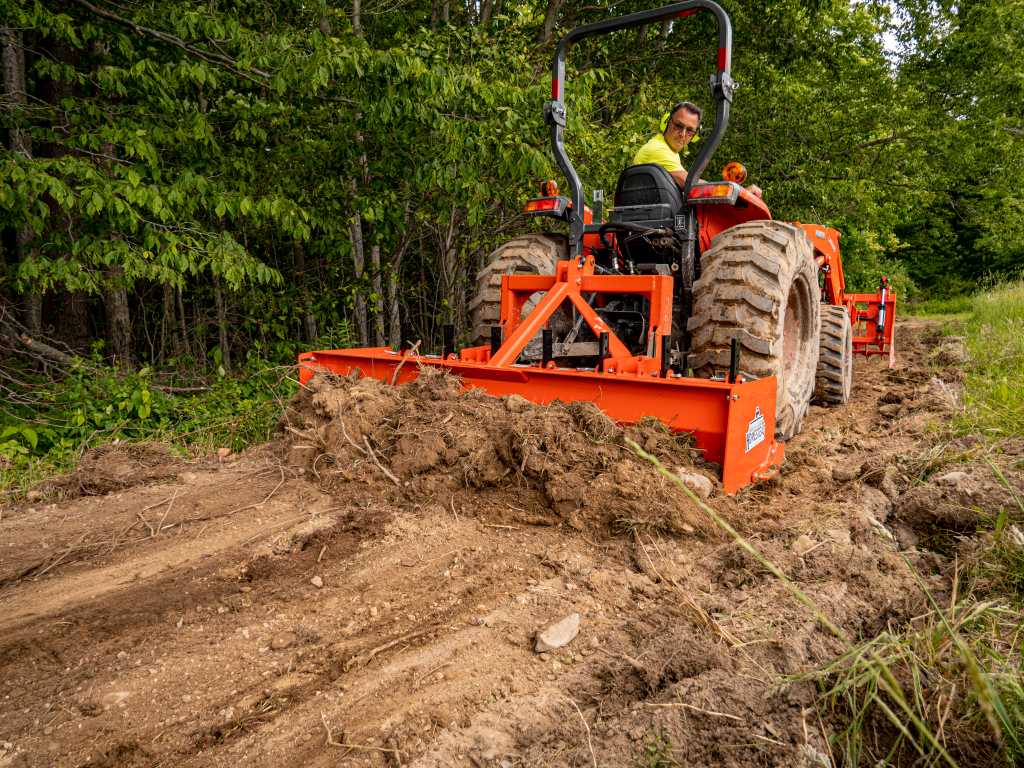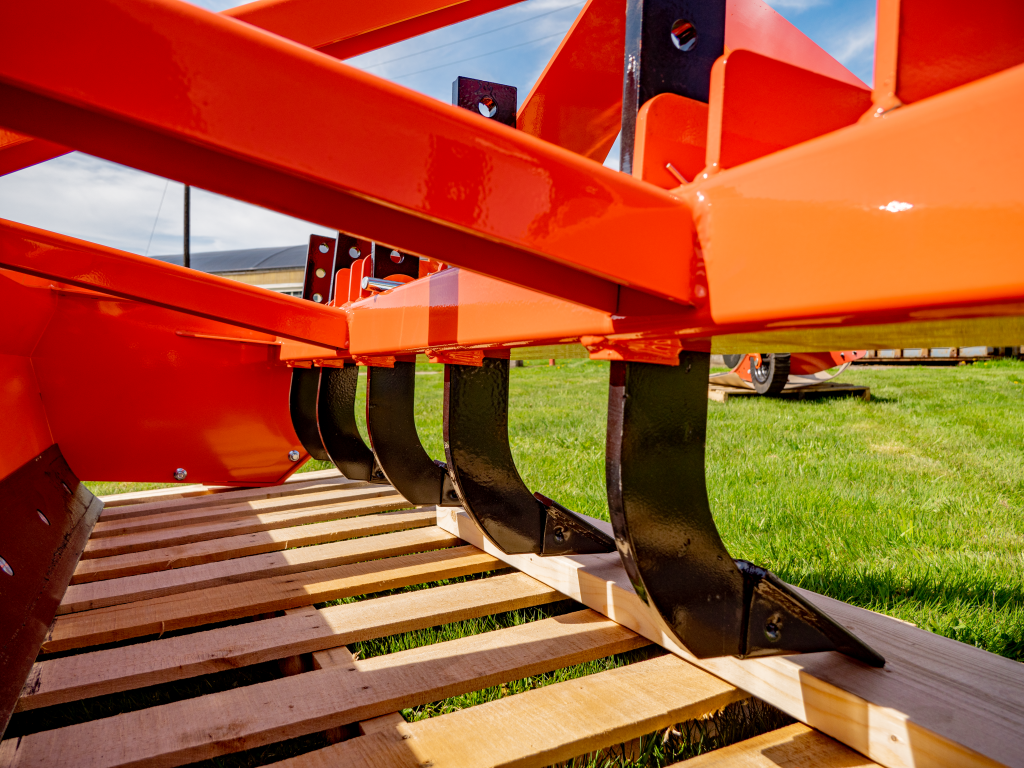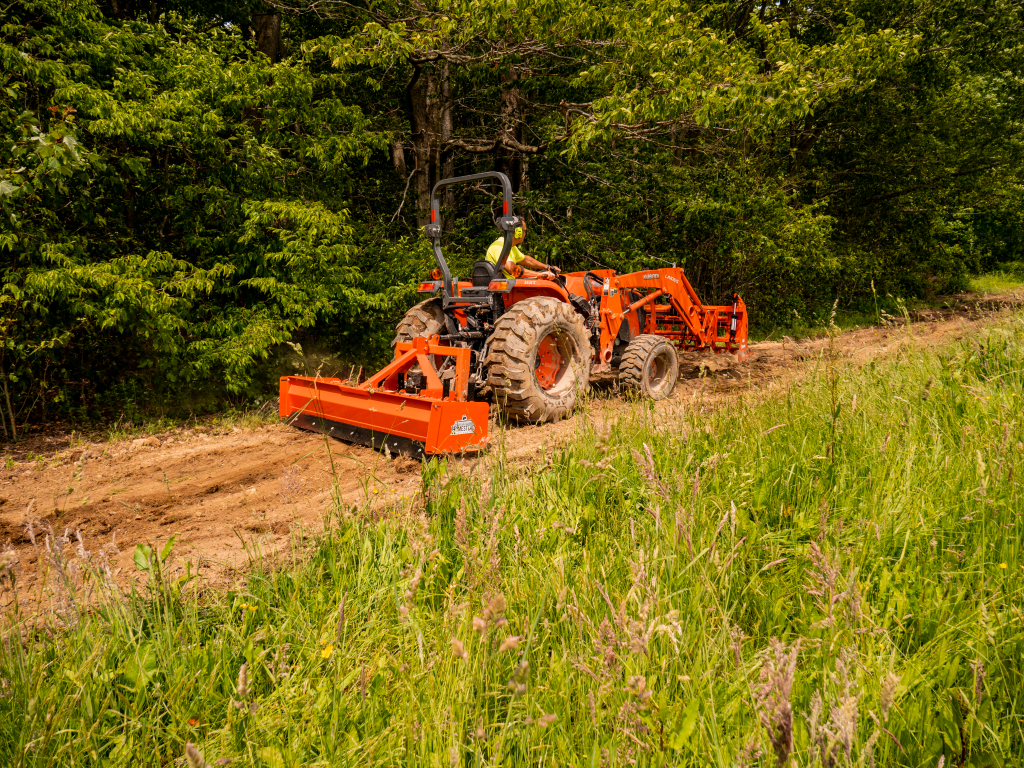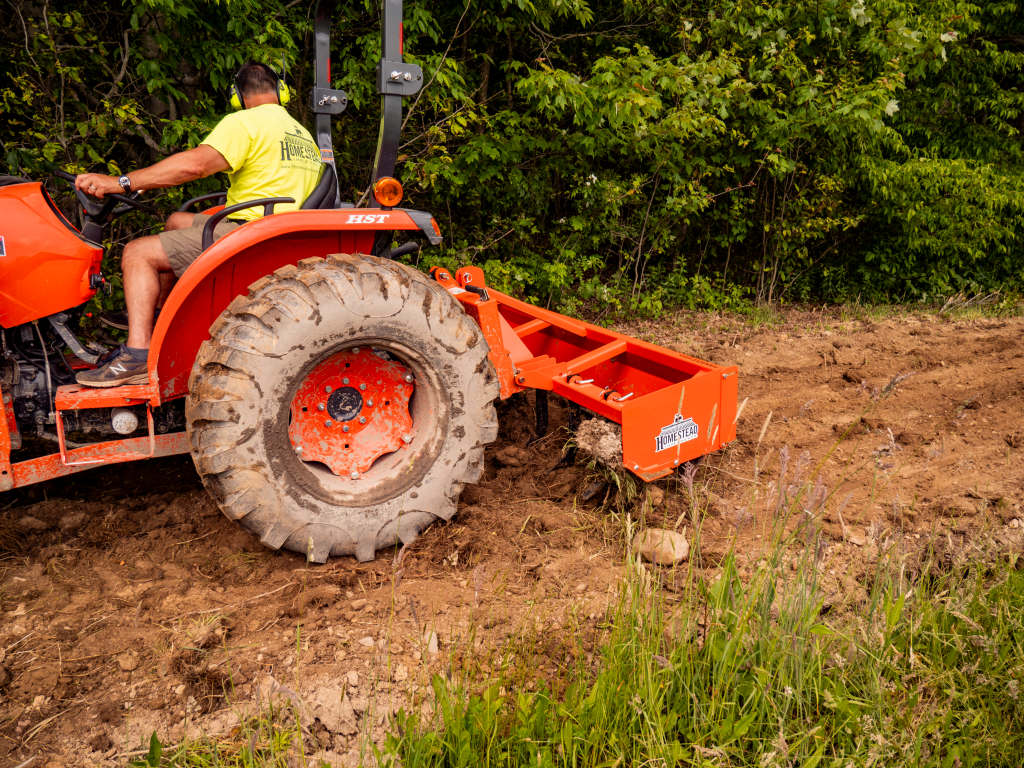When it comes to tractor implements, a box blade is one of the most versatile and essential tools any tractor owner can have in their arsenal. This comprehensive guide delves into the ins and outs of a box blade for tractors, shedding light on their utility, how they compare with other tractor attachments, and offering insights on the best choices for specific tractor sizes. Box blades tend to last a really long time when used properly, so it will pay off big time to know what to look for in various construction and design and also how to, and how not to use your box blade. Let’s have a look at what you need to know.
What Is A Box Blade Used For?
A tractor box blade is arguably the first implement you should consider for purchase. Besides functioning as a compact counterbalance for working with your front-end loader, a box blade makes an excellent tool for grading roads, establishing firebreaks, and spreading aggregates like gravel or limestone on a driveway. While the versatility of the box blade is part of its value, there are alternative implements that do a better job of certain tasks.
Land Plane Vs Box Blade
The land plane and the box blade have distinct designs and serve slightly different primary purposes. A land plane is a dual-bladed tool, and it typically has two long blades positioned in the middle and set at a slight angle. It might also include scarifiers in some designs, but they don’t have a boxy design. The land plane excels at finishing jobs. If you’ve got a rough or undulating surface, the land plane helps to smoothen and level it. It’s particularly useful after primary grading or after heavy rains that may have eroded surfaces. Land planes are great for maintaining gravel driveways. They help spread the gravel evenly and fill in potholes. The land plane’s strengths lie in fine-leveling tasks because it doesn’t accumulate material between the blades, which ensures even leveling. It is also simple to use for those new to tractor implements.

A box blade, as the name suggests, looks like a box and usually has front and rear scraping blades. In addition, it has scarifiers (or rippers) which can be adjusted to dig into the soil to a desired depth. It is more aggressive and is best used for grading tasks, cutting through hard surfaces, or leveling out larger inconsistencies in the terrain. If you need to spread material like soil, gravel, or sand evenly, the box blade is your go-to. It can carry material in its “box” and spread it out as it moves. It can also clear vegetation down to the soil, creating effective firebreaks. A box blade for tractors finds its strengths in versatility due to its scarifiers and dual blades. It can dig, grade, and spread material and is effective for both light and heavy-duty tasks.
While there is some overlap in functionality, the choice between a land plane and a box blade often comes down to the specific task at hand. If the primary need is fine-leveling and smoothing, especially for driveways, a land plane is more suitable. On the other hand, for more aggressive tasks like grading, digging, and material spreading, a box blade is the better choice. Understanding the nuances of each tool, you may find that you need both, but if I could only choose one, it would be the box blade unless the only thing I was doing was maintaining an existing driveway.
Box Blade Vs Grader Blade
While they might appear to serve similar functions, there are distinct differences in design and application of the box blade and the grader blade (also known as a back blade). A grader blade, often referred to simply as a “blade,” is a single long blade that can be adjusted to various angles relative to the direction of the tractor’s movement. Some models offer the capability of tilting the blade, allowing for more intricate grading maneuvers. The grader blade is superb for tasks like maintaining roads or driveways, smoothing out surfaces after tilling, or redistributing material along a slope. In many settings, grader blades are used to clear snow from roads and driveways. By setting the blade at an angle, you can create shallow ditches or water runoffs. If you’re working on tasks that require moving, spreading, and leveling substantial amounts of material, or breaking up compacted soil, a box blade is your best choice. However, if you’re maintaining roads, driveways, or looking for precision grading and shaping of landscapes, a grader blade will serve you better.
Choosing A Box Blade Size For Your Tractor
I wanted to know more about how to size a box blade as well as what to look for in their construction, and who better to give me those answers than the experts who answer those questions every day? Homestead Implements designs and manufactures box blades, land planes, and back blades along with other 3-point implements and front-end loader attachments right here in the USA. I recently spoke to Homestead’s Travis Hoyt to learn more about sizing a box blade and what to look for in their construction.
Homestead Implements designs 4ft box blades as well 5ft, 6ft, and 7ft models. With many different sizes available, is bigger better? Here’s what Travis had to say, “So the biggest thing for choosing would be making sure that it fits outside of the width of your tractor. Because if you’re not covering your tracks, you’re not using it to the fullest potential. You want to make sure that you can cover your tracks to use it, but you also don’t want to go too large where when you start to fill up the box with material you start to bog down and stall and you can’t actually pull the material you’re working with.”
Analyzing A Box Blade For Sale
When inspecting a box blade for sale, there are several areas to inspect in both design and construction. “So there’s a few things that you really want to look for. The first thing that most people don’t really look at is the material. Is it a hardened carbon steel? “Also things like gussets are super helpful because they strengthen your box blade so that in critical areas with your box typically you’ll see triangular gussets in the corners to add extra strength. So when you’re pulling heavier material, it keeps the rigidity of the strength of the box. You also can have them in places like behind the ripper shank. So if you’re using it and you catch a root, the ripper shank isn’t going to pull through the box blade. It’s actually going to stop it and allow it to actually shear the way it’s supposed to protect your tractor.”
Box Blade Rippers And Cutting Edges
Another consideration is the scarifiers or rippers. “With ripper shanks a lot of times you may not think you need them but a lot of times you may need them down the road. With a higher-end box blade, they come with the ripper shanks for you to use at that point. Another thing you want to think about is the cutting blades. Make sure you have the type of cutting blades that are high carbon heat treated, reversible, and replaceable?” This will allow you to work in both forward and reverse and allow you to replace blades as they wear over time.

Box Blade Extras
Box blades are notoriously heavy, and for some reason whenever I get out the heavy equipment and start doing the sweaty work around my place, my help tends to disappear. For that reason, you may eventually want to upgrade your tractor to many of the quick hitch systems that allow you to quickly change implements without any help. Make sure your implement is quick hitch compatible, even if you don’t currently have a quick hitch. Given enough time behind the wheel, it’s likely you’ll want to upgrade.
How To Use A Box Blade
A box blade is a versatile implement, but knowing how to use it correctly is crucial for achieving optimal results and ensuring safety. Let’s explore these aspects in detail:
- Attachment: Begin by securely attaching the box to your tractor, ensuring that all pins are in place and the implement is level.
- Adjust the Scarifiers: Depending on the depth you want to dig or grade, set the scarifiers. For breaking up hard soil, set them to dig deeper, but for light grading, you might not need them at all.
- Set the Blade Angle: For general grading, keep the blade level to the ground. For more specific tasks, like crowning a road, you will want to angle it using the tilt adjustment on your 3-point hitch. For more aggressive tasks, like busting through sod, you will want to adjust your top link shorter so that your teeth will dig in more.
- Start Slow: Especially if you’re new to using this type of implement, start at a slower tractor speed until you get the feel of the implement.
How To Use A Box Blade On A Gravel Driveway
- Check the Driveway: Identify potholes, uneven areas, and sections where the gravel has been pushed to the side.
- Set the Scarifiers: If you need to break up compacted areas, adjust the scarifiers to a shallow depth.
- Begin Grading: Move slowly down the driveway, allowing the box blade to pull gravel from the high spots and deposit it in the low spots.
- Cross Grading: To ensure an even surface, make multiple passes in different directions, if necessary.
- Smooth the Surface: Finish by making a pass without the scarifiers, allowing the rear blade to smooth out the surface.
How To Use A Box Blade To Level Ground
- Inspect the Area: Identify high spots, depressions, or debris in the area.
- Deep Leveling: If the ground is uneven, use the scarifiers to break it up and move soil from elevated areas to fill in depressions.
- Shallow Leveling: Once the major inconsistencies are addressed, make additional passes without the scarifiers, using only the blades to fine-tune and smooth the surface.
- Compact the Soil: After leveling, you might want to use a roller or other compaction tool to ensure the ground is stable.

How Not To Use A Box Blade
- Avoid High Speeds: Moving too quickly can result in uneven grading and might damage the implement or the tractor.
- Don’t Force It: If it isn’t cutting or leveling as expected, avoid forcing it deeper by adding weight or pushing it down. Instead, adjust the scarifiers or blade angle.
- Steer Clear of Obstacles: Underground obstacles like rocks or tree roots can damage the scarifiers or blades. Be sure to clear the area as much as possible beforehand.
- Not for Trenching: They are not designed for digging deep trenches. For such tasks, use specialized implements.
- Regular Maintenance: Not maintaining the box blade, like ensuring its blades are sharp and all parts are in good condition, can lead to inefficient operation and potential damage.
Box Blade Final Say
A box blade, when used with knowledge and precision, can be one of the most indispensable tools in a land manager’s arsenal. Its use in a variety of applications, from driveway maintenance to land leveling to firebreaks, exemplifies its versatility. However, like all tools, its efficacy lies in the hands of its operator. By understanding the nuances of its operation, recognizing its strengths, and being aware of common missteps, one can truly harness the full potential of this implement. As with all machinery, regular maintenance and safety precautions are paramount. With proper attention paid to construction and design, an operator can choose a box blade that can serve its purpose effectively, ensuring many years of hard use.




